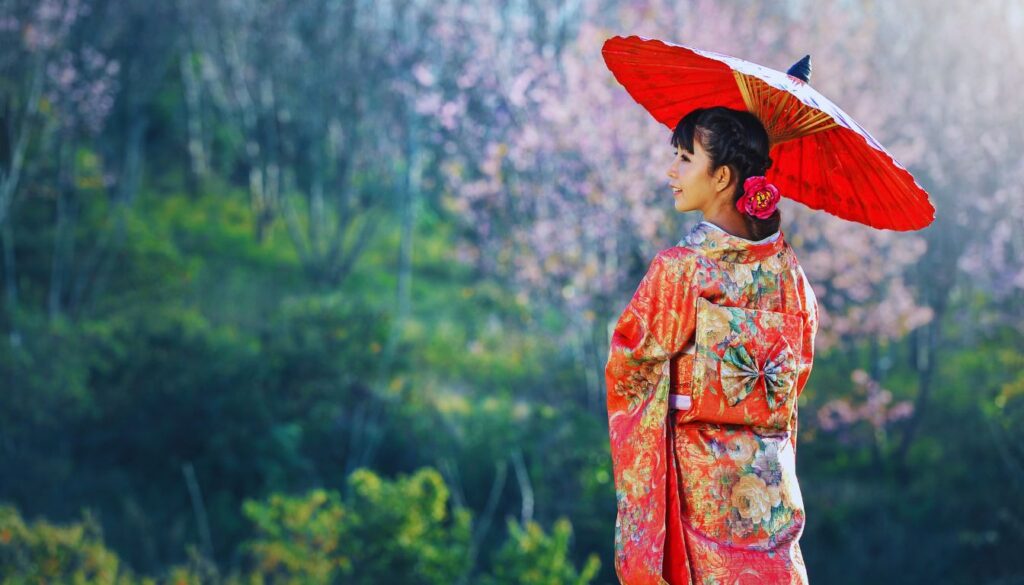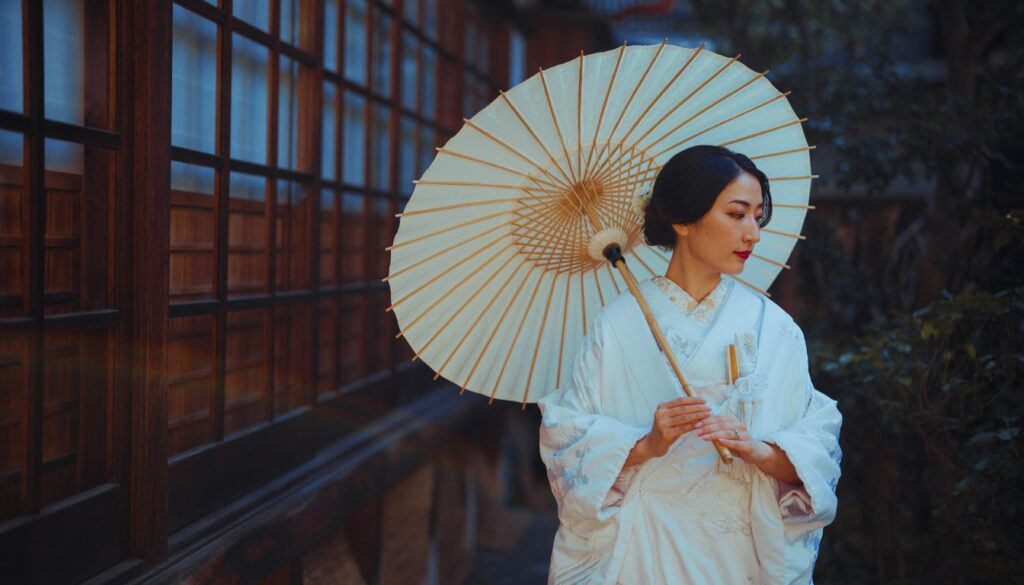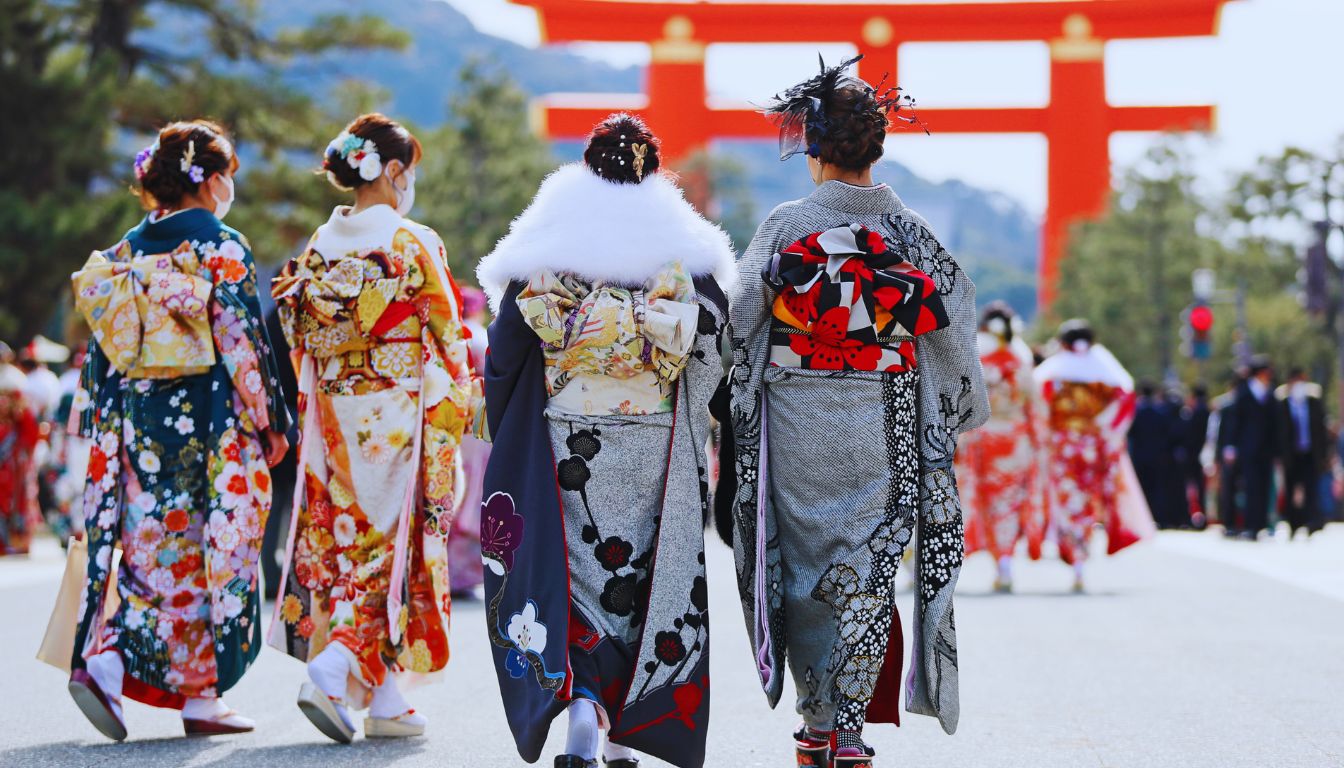The kimono is a symbol of Japan’s deep cultural roots. It has a history of over 2,300 years. This elegant dress has grown more refined over time.
In the Heian period, about 1,300 years ago, the kimono started to take shape. It became a vibrant part of the aristocracy’s culture.
By the Edo period, around 400 years ago, kimonos became common wear. People wore them to show their unique style. The Meiji period, about 160 years ago, changed the kimono’s role. It became a special-occasion dress.
Now, kimonos are seen at formal events and cultural gatherings. They represent Japan’s traditional beauty.
Table of Contents
The Enduring Legacy of Kimono
The Kimono Japanese Traditional Dress has a long history, over 2,300 years. In the Heian period, about 1,300 years ago, kimonos were a big part of the aristocracy’s life. They became more elegant over time.
By the Edo period, around 400 years ago, kimonos were for everyone. People wore them to show who they were and their lifestyle.
The Meiji period, about 160 years ago, brought Western influence. This made kimonos special, not just for daily wear. Yet, the Kimono Japanese Traditional Dress still shows Japan’s rich culture.
“Kimono Refashioned” opened at the Newark Museum in October 2018. It then went to the Asian Art Museum in San Francisco in February 2019. The exhibit will end its tour at the Cincinnati Museum in June. This shows how much the Kimono Japanese Traditional Dress is loved worldwide.
Crafting the Kimono: An Artisanal Marvel

Making a Kimono Japanese Traditional Dress is a true marvel of craftsmanship. Japanese artisans put their heart and soul into every piece. There are mainly two types: dyed kimonos and woven kimonos.
Dyed kimonos are perfect for both special events and daily wear. They use many dyeing techniques. “Yuzen dyeing” stands out for its detailed, artistic designs.
The Yuzen dyeing process takes about 20 steps. Each step requires the skill of experienced artisans. Some kimonos need many artisans to complete, showing the teamwork involved.
Woven kimonos, or “Tsumugi,” are made from silk threads dyed before weaving. “Yuuki Tsumugi” is special. It’s made from hand-spun silk in Ibaraki and Tochigi. It’s known for its lightness, warmth, and top-notch craftsmanship. UNESCO has recognized it as an Intangible Cultural Heritage.
Motifs and Patterns: Nature’s Whispers Woven into Fabric
The Kimono, Japan’s iconic traditional dress, is a mix of nature-inspired motifs and bright colors. Each pattern has its own deep meaning. Cherry blossoms, Japan’s favorite flower, are often used in Kimono designs. There are rules about when to wear them.
The asanoha, or hemp leaf pattern, is made of interlocking hexagonal shapes. It’s seen as lucky and helps keep evil away. It also wishes for children to grow healthy and strong.
The crane, a symbol of long life and happy marriage, is also a common Kimono motif. It’s often worn on special days. These patterns show Japan’s love for nature and the importance of matching clothes with the seasons.
Kimono design is very flexible, with many techniques used to make beautiful patterns. You’ll find intricate embroidery, bright dyes, and new weaving methods. Each Kimono is a unique piece of art, filled with nature’s whispers and the skill of Japanese artisans.
Kimono: A Versatile Wardrobe for All Seasons
The Kimono, a Japanese traditional dress, is incredibly versatile. It has a history of over 2,300 years. This timeless garment has changed with the times, becoming a wardrobe essential. It keeps you cool in summer and warm in winter.
The Kimono’s design and fit are key to its appeal. Its wide obi sash allows for a snug waistline, fitting all ages and sizes. This has made it a favorite for centuries, from the Heian aristocracy to Edo commoners.
Layering is the secret to the Kimono’s season-changing magic. In summer, a light Kimono keeps you cool. In winter, layer multiple ones for warmth. Adding a haori jacket makes it even cozier and stylish.
The Kimono’s flexibility in weather and style makes it a wardrobe must-have. It’s perfect for a classic look or practical needs. It showcases traditional Japanese craftsmanship and the timeless beauty of this iconic garment.
Kimono Japanese Traditional Dress: A Fashion Statement
The Kimono Japanese Traditional Dress is a timeless beauty with deep cultural roots. It has caught the eye of the global fashion world and pop culture. Brands like Alexander McQueen and Vivienne Westwood have added Kimono touches to their designs.
Kimonos have also shown up in big movies and TV shows. They are seen in films like “The Last Samurai” and “Sayuri.” This has made the Kimono a global fashion icon.
Artists like Madonna have also worn Kimonos in their videos. This has made the Kimono even more popular. It’s a symbol of Japan’s rich culture and a fashion statement around the world.
The Kimono’s designs and versatility inspire fashion everywhere. It’s a timeless piece that continues to influence trends. It’s a true sartorial masterpiece.
The Sustainable Beauty of Kimono

Kimonos are not just beautiful; they’re also sustainable. Made from one piece of fabric, they can be changed and dyed many times. This shows the lasting beauty of the Kimono Japanese Traditional Dress.
The process of re-dyeing, called “Iroage,” is simple. It involves pouring color right over the fabric. “Nukizome” removes old color and adds a new one. “Mehiki” dyes over the original pattern, keeping the design intact.
Also, kimonos are made from natural materials like silk, hemp, and cotton. This makes them good for the environment. Today, people are making kimonos into new clothes and accessories. This shows how kimonos keep traditional Japanese culture alive while being eco-friendly.
The beauty of kimonos shows the skill and creativity of Japanese textile makers. As we look for greener fashion, kimonos are a great example. They show how old traditions and new eco-friendly ideas can work together. This could lead to a future where fashion and caring for the planet go together.
Kimono in Pop Culture: A Global Phenomenon
The Kimono Japanese Traditional Dress has become famous worldwide. It’s seen in movies, TV shows, and music. This has made it a key part of global pop culture.
Movies like “The Last Samurai” and “Sayuri” have shown the Kimono’s beauty and meaning. They’ve caught the attention of many viewers. Pop star Madonna has also used Kimonos in her music videos, reaching more people.
Kimono fashion shows and exhibitions are now popular globally. These events let people see the beauty and art of the Kimono. They celebrate the dress’s cultural value and its impact on fashion.
The Kimono has won hearts around the world. It’s a big part of pop culture. Its lasting influence inspires many, showing its universal appeal.
Experience the Magic: Kimono Exhibitions and Events
For those eager to explore the world of Kimono Japanese Traditional Dress, there are many exhibitions and events worldwide. These events let visitors see the detailed craftsmanship and vibrant designs of the Kimono. They also learn about the deep symbolism behind it.
Kimono fashion shows and exhibitions on its history are great ways to connect with Japanese tradition. Organizations like Shin Edupower help by offering educational programs. They let students and fans dive into the fascinating world of the Kimono.
The “Kimono: Kyoto to Catwalk” exhibition at the Victoria and Albert Museum in London showed how Japanese Kimono culture evolved. The “Kimono Magic Society” group exhibition was also held there. These events celebrate the Kimono’s beauty and let artists show their creative takes on it.
If you love fashion or Japan’s culture, these exhibitions and events are for you. They offer a deep and memorable experience. So, don’t miss the chance to explore the enchanting world of the Kimono.
Preserving the Art: Cultural Initiatives and Collaborations
The Kimono Japanese Traditional Dress is gaining more fans worldwide. Groups like Shin Edupower are leading the way to save this iconic garment. They offer educational programs and cultural experiences that connect people with the Kimono’s deep history.
These efforts share the Kimono’s detailed craftsmanship, colorful designs, and deep meanings with more people. This helps keep the Kimono’s legacy alive. It also supports cross-cultural projects and cultural learning, keeping the Kimono’s beauty and Japan’s cultural identity alive.
Preserving cultural heritage is crucial, as seen in the backlash against Kim Kardashian’s “Kimono” shapewear line. It showed the importance of respecting cultural traditions and intellectual property rights. This highlights the need for sustainable fashion that values cultural heritage.
Organizations like Shin Edupower are key in keeping the Kimono’s legacy alive. They support educational partnerships and cultural experiences. These efforts not only save the Kimono’s art but also promote fashion that respects and celebrates cultural diversity.
Conclusion
The kimono Japanese Traditional Dress is more than a piece of clothing. It shows Japan’s deep Japanese cultural heritage, skill, and care for the environment. From simple clothes to a symbol of elegance, the kimono has won hearts worldwide.
As more people around the globe fall in love with the kimono, efforts to keep its art and tradition alive are crucial. Programs, cultural experiences, and sustainable fashion practices help protect and share the kimono’s story. This way, its legacy is kept safe and celebrated by all.
The kimono’s lasting charm and its role in connecting cultures are truly remarkable. It shows the beauty of human creativity and traditional skills. The global cultural exchange around the kimono reminds us of the deep impact of cultural traditions. It enriches our understanding and appreciation of the world’s diverse artistic expressions.
Discover the must-visit cultural destinations of Japanese culture













